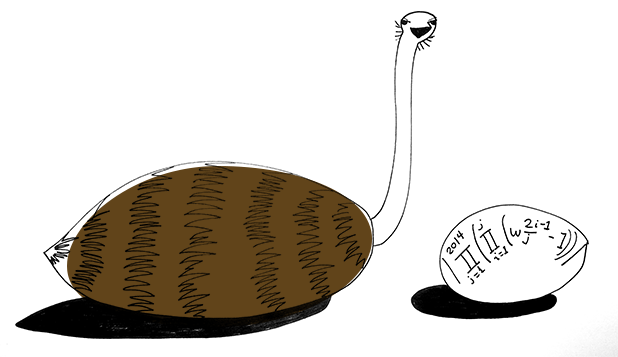Expanding Seems Implausible
 Let
ω
n
=
e
i
π
/
n
. The value of
∣
∣
∣
∣
∣
j
=
1
∏
2
0
1
4
(
i
=
1
∏
j
(
ω
j
2
i
−
1
−
1
)
)
∣
∣
∣
∣
∣
can be expressed as
a
b
where
a
,
b
are positive integers and
a
is as small as possible. What is
a
+
b
?
Let
ω
n
=
e
i
π
/
n
. The value of
∣
∣
∣
∣
∣
j
=
1
∏
2
0
1
4
(
i
=
1
∏
j
(
ω
j
2
i
−
1
−
1
)
)
∣
∣
∣
∣
∣
can be expressed as
a
b
where
a
,
b
are positive integers and
a
is as small as possible. What is
a
+
b
?
The answer is 2016.
This section requires Javascript.
You are seeing this because something didn't load right. We suggest you, (a) try
refreshing the page, (b) enabling javascript if it is disabled on your browser and,
finally, (c)
loading the
non-javascript version of this page
. We're sorry about the hassle.
2 solutions
Well, you could have used x j − 1 = i = 1 ∏ j ( x − ω j 2 i ) , and then the substitution x = ω j , to solve it.
Did you prove your claim for the general case? But anyways, good job! :) you managed to overcome the notation.
The trend does not go on after n = 3, for example for n = 4, the value of the inner product equals 0.585786438.
How did you get the index and the bounds of the product to be actually above and below the pi? When I try, it goes to the right of the pi.
For any j , define a polynomial P ( x ) with roots ω j 2 i − 1 − 1 for 1 ≤ i ≤ j . We have that ( ω j 2 i − 1 ) j = ( ω j j ) 2 i − 1 = ( − 1 ) 2 i − 1 = − 1 . Therefore, ( ω j 2 i − 1 − 1 + 1 ) j + 1 = 0
Suppose r j = − 1 for some r . Then r = ( e i π / j ) 2 n − 1 for some n such that 1 ≤ n ≤ j . Therefore, P ( x ) = ( x + 1 ) j + 1 because the polynomial is 0 at these points and no other points (If there was another root, setting r = x + 1 would quickly give a contradiction).
The product of the roots of a polynomial is the constant term if the degree of the polynomial is even and the negative of the constant term if the degree is odd. The constant term of this polynomial for any j is clearly 2. Therefore, the product for and j is 2 if j is even and -2 if j is odd.
We are now looking for the product ∏ j = 1 2 0 1 4 ( − 2 ) j , which is clearly the same as 2 2 0 1 4 . We now have a = 2 and b = 2 0 1 4 , so a + b = 2 0 1 6 .
There is a mistake in the last step....it is not (-2)^j....it is 2 ×( -1)^j.
For j = 1 note that i = 1 ∏ j ω j 2 i − 1 = ( ω 1 − 1 ) = − 2 as ω 1 = − 1 .
For j = 2 expansion of the product gives i = 1 ∏ j ω j 2 i − 1 = ( i − 1 ) ( − i − 1 ) = 2 .
Similarly for j = 3 we have i = 1 ∏ j ω j 2 i − 1 = ( ω 3 − 1 ) ( ω 3 3 − 1 ) ( ω 3 5 − 1 ) = ( − 2 ) ( ω 3 − 1 ) ( ω 3 5 − 1 ) = ( − 2 ) ( ω 3 − 1 ) ( − ω 3 2 − 1 ) = ( − 2 ) ( ω 3 6 − ω 3 + ω 3 2 + 1 ) = − 2 .
The last equality follows from the relation ( 1 − ω 3 + ω 3 2 ) = 0 because ω 3 3 = − 1 .
Following similar argument we see that ∣ j = 1 ∏ 2 0 1 4 i = 1 ∏ j ( ω j 2 i − 1 − 1 ) ∣ = ∣ ( − 2 ) × 2 × ( − 2 ) × ⋯ × 2 ∣ = 2 2 0 1 4 .